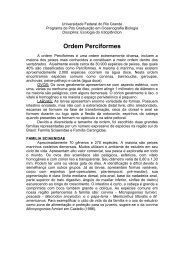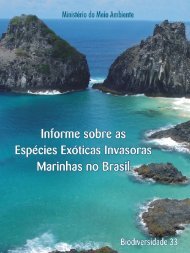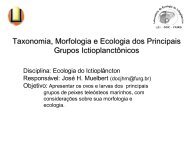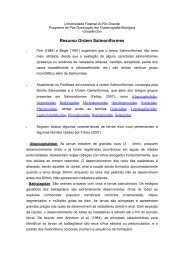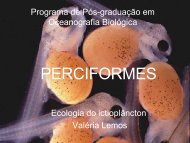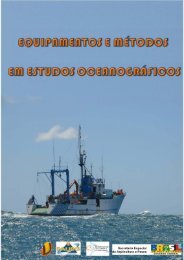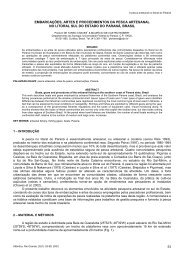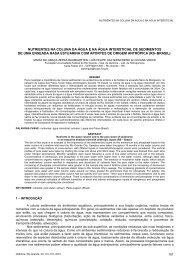Artigo Completo - Laboratório de Ecologia do Ictioplâncton - Furg
Artigo Completo - Laboratório de Ecologia do Ictioplâncton - Furg
Artigo Completo - Laboratório de Ecologia do Ictioplâncton - Furg
- No tags were found...
You also want an ePaper? Increase the reach of your titles
YUMPU automatically turns print PDFs into web optimized ePapers that Google loves.
PERSICH, GR & VMT GARCIAda costa. Estes ambientes são propícios à <strong>de</strong>posição e ao acúmulo <strong>do</strong>s cistos, po<strong>de</strong>n<strong>do</strong> apresentar maioresconcentrações <strong>de</strong> cistos <strong>do</strong> que as observadas na presente investigação.AGRADECIMENTOSAo Conselho Nacional <strong>de</strong> Desenvolvimento Cientifico e Tecnológico (CNPq) pela concessão das bolsas<strong>de</strong> <strong>do</strong>utora<strong>do</strong> e <strong>do</strong>utora<strong>do</strong> sanduíche à primeira autora, ao professor Matsuoka pelas informações recebidascom relação à meto<strong>do</strong>logia <strong>de</strong> amostragem, processamento e i<strong>de</strong>ntificação <strong>do</strong>s cistos <strong>de</strong> dinoflagela<strong>do</strong>s.Ao amigo Valnei Rodrigues pelo auxílio logístico, ao Renato Espírito Santo, Dr. Lauro Calliari e Denis Dolci peloauxílio na coleta <strong>de</strong> sedimento. À Dra. Clarisse O<strong>de</strong>brecht e Dra. Maria Célia Villac pelas críticas e sugestõesrecebidas.REFERÊNCIASANDERSON, DM 1980. Effects of temperature conditioning on <strong>de</strong>velopment and germination of Gonyaulux tamarensis (Dinophyceae)hypnozigotes. J. Phycol., 16: 166-172.ANDERSON, DM 1984. Shellfish toxicity and <strong>do</strong>rmant cysts. In: RAGELIS, E P (ed.). Toxic Dinoflagellate Blooms. Seafood Toxins. Amer.Chem. Soc. Symposium Series N0. 262. Wash. D. C.: 125-138.ANDERSON, DM 1997. Bloom dynamics of toxic Alexandrium species in the northeastern U. S. Limnol. Oceanogr. 42 (5, part.2): 1009-1022.ANDERSON, DM 1998. Physiology and bloom dynamics of toxic Alexandrium species, with emphasis on life cycle transitions. In: ANDERSON,DM, A CEMBELLA & G HALLEGRAEFF (eds.). Physiological Ecology of Harmful Algal Blooms. Springer, 29-48.ANDERSON, DM, Y FUKUYO & K MATSUOKA. 1995. Cyst metho<strong>do</strong>logies. In: HALLEGRAEFF, G, DM ANDERSON & A CEMBELLA (eds.).Manual on Harmful Marine Microalgae., UNESCO, Paris: 229-249.ANDERSON, DM, CD TAYLOR, & V ARMBRUST. 1987. The effects of darkness and anaerobiosis on dinoflagellate cyst germination. Limnol.Oceanogr., 32(2):340-351ANDERSON, DM & D WALL. 1978. Potential importance of benthic cysts of Gonyaulax tamarensis and G. excavata in initiating toxicdinoflagellate blooms. J. Phycol., 14(2): 224-234.AKSELMAN, R. 1987. Quistes planctonicas <strong>de</strong> dianoficeas en areas <strong>de</strong> plataforma <strong>de</strong>l Atlantico Su<strong>do</strong>cci<strong>de</strong>ntal, I. Reporte taxonomico <strong>de</strong> lafamilia Peridiniaceae Ehrenberg. Bolm Inst. Oceanogr., S. Paulo, 35 (1): 17-32.BENAVIDES, H, L PRADO, S DÍAZ,. & JI CARRETO. 1995. An exceptional bloom of Alexandrium catenella in the Beagle Channel, Argentina.In: LASSUS, P, G ARZUL, E ERARD, P GENTIEN & C MARCAILLOU (eds.). Harmful Marine Algal Blooms. Lavousier, Intercept Ltd:113-118.BINDER, BJ & DM ANDERSON. 1990. Biochemical composition and metabolic activity of Scrippsiella trochoi<strong>de</strong>a (Dinophyceae) resting cysts.J. Phycol., 26:289-298.BOLCH, CJ & GM HALLEGRAEFF. 1990. Dinoflagellate cysts in recent marine sediments from Tasmania, Australia. Botanica Marina,33: 173-192.BRAZEIRO, A, S MENDÉZ & G FERRARI. 1997. The first toxic bloom of Alexandrium tamarense in Uruguay: associated environmental factors.Atlântica, Rio Gran<strong>de</strong>, 19: 19-29.CALLIARI, LJ, AHF KLEIN & FCR BARROS. 1996. Beach differentiation along the Rio Gran<strong>de</strong> <strong>do</strong> Sul coastline (Southern Brazil). RevistaChilena <strong>de</strong> Historia Natural 69: 485-493.CALLIARI, LJ, NS SPERANSKI, & M TORRONTEGUY. 1999. O "efeito lama" na ante-praia <strong>do</strong> Cassino. características, processos e efeitos.VII Cong. ABEQUA (Porto Seguro, BA).CARRETO, JI, NG MONTOYA, ADC COLLEONI, & R AKSELMAN. 1998. Alexandrium tamarense blooms and shellfish toxicity in the Argentinesea: a retrospective view. In: REGUERA, B, J BLANCO, ML FERNÁNDEZ & T WYATT (eds.). Harmful Algae. Xunta <strong>de</strong> Galicia andIntergovernmental Oceanographic Comission of UNESCO. Chap 2: 131-134.CARRETO, JI, RM NEGRI, HR BENAVIDES & R AKSELMAN. 1985. Toxic dinoflagellate blooms in the Argentine Sea. In: ANDERSON, DM,AW WHITE, & DG BADEN (eds). Toxic Dinoflagellates. Elsevier Science Publishing Co, Chap 2:147-152.CASTELLO, JP, AK DUARTE, OO MÖLLER JR, LF NIENCHESKI, C ODEBRECHT, G WEISS, RP HABIAGA, VR BELLOTTO, D KITZMANN,C SOUTO, RB SOUZA, AM CIOTTI, G FILLMANN, PR SCHWINGEL, JG BERSANO, M CIRANO, K FREIRE, I LIMA, R MELLO, AMONTEIRO, C JR. RESGALA, I SOARES, & M SUZUKI. 1990. On the importance of coastal and subantartic waters for the shelfecosystem off Rio Gran<strong>de</strong> <strong>do</strong> Sul. Publ. Acad. Ciências Est. S. Paulo, 71: 112-129,.CEMBELLA, A. 1998. Ecophysiology and metabolism of paralytic shellfish toxins in marine microalgae. In: ANDERSON, DM, A CEMBELLA & GHALLEGRAEFF (eds.). Physiological Ecology of Harmful Algal Blooms, Springer, Berlin: 381-403.CIOTTI, AM, C ODEBRECHT, G FILLMANN & OO MÖLLER Jr. 1995. Freshwater outflow and Subtropical Convergence influence onphytoplankton biomass on the southern Brazilian continental shelf. Cont. Shelf. Res. 15(14):1737-1756.CORRÊA, ICS, JA VILLWOCK, FI ISLA, JL LABORDE, JM JACKSON, VV FURTADO & LJ CALLIARI. 1996. Atlas morphology andsedimentology of the southwest Atlantic coastal zone and Continental Shelf from Cabo Frio (Brazil) to Península Valdés (Argentina).MARTINS e CORRÊA (eds.). Ponto Um/UFRGS-IG-CECO, Porto Alegre. 20 mapas.DALE, B. 1977. Cysts of the toxic red-ti<strong>de</strong> dinoflagellate Gonyaulax excavata Balech from Oslofjor<strong>de</strong>n, Norway. Sarsia, 63: 29-34,.DALE, B. 1983. Dinoflagellate resting cysts. In: FRYXEL, GA (ed.). Survival strategies of the algae. Cambridge:69-136.FACHINI, S. 1998. Caracterização <strong>do</strong> perfil <strong>de</strong> equilíbrio da antepraia na costa <strong>do</strong> Rio Gran<strong>de</strong> <strong>do</strong> Sul. Tese <strong>de</strong> Mestra<strong>do</strong>, Universida<strong>de</strong> Fe<strong>de</strong>ral<strong>do</strong> Rio Gran<strong>de</strong> <strong>do</strong> Sul- Curso <strong>de</strong> Pós-Graduação em Geociências, RS, UFRGS, 114p.FERRARI, G & S MÉNDEZ. 2000. Report of phytoplankton species producing coastal water discoloration in Uruguay. Iheringia, Sér. Bot.,54: 3-18.GARCIA, VMT, C ODEBRECHT & LR RÖRIG. 1994. Florações nocivas <strong>de</strong> fitoplâncton na costa brasileira. IOC Workshop ReportNo. 101: 9-14.GARCIA,VMT & NM GIANUCA. 1997. The beach and surfzone. In: SEELIGER, U, C ODEBRECHT & JP CASTELLO (eds.) SubtropicalConvergence Environments: The Coast and Sea in the Southwestern Atlantic. Springer-Verlag, Hei<strong>de</strong>lberg, New York, Chap. 7: 166-170.132Atlântica, Rio Gran<strong>de</strong>, 25(2): 123-133, 2003.



